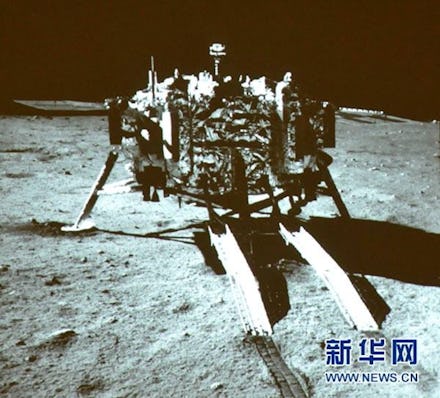4 Photos From China's Historic Landing On the Moon

The news: On Saturday, China's unmanned Chang'e-3 probe landed on the surface of the moon, becoming the first craft to have "soft-landed" on the moon in 37 years. Chang'e-3, named after a lunar goddess from Chinese folklore, is accompanied by Yutu (Jade Rabbit), a six-wheeled, solar-powered rover toting four cameras, an array of analytical equipment, and two arms designed to retrieve soil samples from the lunar surface.
Here are four of the first photos it took of our heavenly companion from the ground level:
What's the big deal? We've done it before. Besides, it's just a rock. You must be a hit at parties.
The last vehicle to soft-land on the moon (touching down relatively gently, with all mechanical components of the craft intact) was the Soviet Union's Luna 24 probe, which landed on the terrifyingly-named Sea Of Crisis in 1976. With this mission, China has become the third country to claim the mantle of direct moon exploration.
How hard is it to soft land? It's the most difficult part of the mission. Consultant editor Peter Bold told the Associated Press:
"It's still a significant technological challenge to land on another world. Especially somewhere like the moon, which doesn't have an atmosphere so you can't use parachutes or anything like that. You have to use rocket motors for the descent and you have to make sure you go down at the right angle and the right rate of descent and you don't end up in a crater on top of a large rock."
If that doesn't sound tense, here's a GIF of the landing approach:
While landing, the probe may have disturbed baseline levels of dust and gas in the extremely thin lunar atmosphere, perhaps making an ongoing NASA lander's mission more difficult as there is no formal cooperation between the U.S. and China's space agencies.
The footage cuts out right before Chang'e-3 collides with an alien's face.
What's the point of the mission? The mission has several objectives. The lander's primary mission is to deploy the Yutu rover, which will explore the moon for three months and take extensive soil samples to determine the composition of the moon's crust and whether or not it can locate usable natural resources. But it also has onboard cameras and a powerful 150 mm Ritchey–Chrétien telescope which will be able to take extremely detailed observations of "galaxies, active galactic nuclei, variable stars, binaries, novae, quasars and blazars in the near-UV band (245-340 nm)."
Yutu is capable of traveling up to 6.2 miles and will survey a 1.2 mile square area. It carries ground-penetrating radar to survey the depth of the lunar crust for up to 98 ft, as well as a spectrometer, cameras, and solar panels. The 260-pound rover can carry up to 44 pounds of lunar samples. Both units will go into sleep mode during the 14-day lunar night.
The rover has a complicated launch process:
- Fire pyros to unlock wheels from lander deck
- Deploy rover solar panels
- Deploy mast and take 360-degree panorama of landing site from atop lander (neat trick, that)
- Cut cable to lander (not sure if this is an umbilical or just a cable tie)
- Deploy landing ramp, which will end in midair
- Drive rover onto landing ramp
- Lower landing ramp toward lunar surface
- Drive off of surface. Rover must drive far enough to get out of comm shadow of the lander. (Rover is driving off the anti-Earth side of lander)
- Communicate with Earth
Here's what Yutu looks like emerging from the lander (minus the lady in pink):
(Credits to NASA Spaceflight forum's belegor for the images.)
Wait, so what color is the moon? Is it gray or brown? It depends on where you are! Chang'e-3's landing region extends outside the Sinis Iridium as well as inside it:
The region includes Laplace A, a crater with a presumably stunning 5,200-foot sheer drop. We'll know just how stunning it is when Yutu photographs it.
The moon, though, is more colorful than you think. Variations on its color are primarily determined by differences in iron and titanium content. Chinese scientists may have also upped the saturation of some of the photos for scientific purposes or to make them more interesting — or the instruments may not have been properly calibrated yet.
The moon's average albedo is 0.136, meaning it reflects 13.6% of light, roughly the same as asphalt. The moon is also covered in dust, so it appears lighter than its surface composition. Finally, you usually see it on a black background (the night sky), so it looks a lot lighter to the naked eye — a visual illusion.